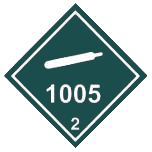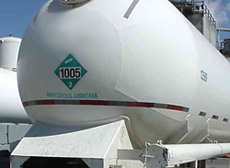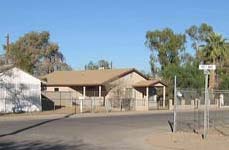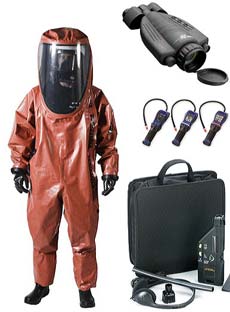Contact Superfund, Pacific Southwest
Pacific Southwest, Region 9
Serving: Arizona, California, Hawaii, Nevada, Pacific Islands, Tribal Nations
Supplemental Environmental Projects at Ammonia Facilities in Arizona and California

Ammonia Sign
Two ammonia refrigeration facilities have volunteered to complete Supplementary Environmental Projects (SEPs), that will benefit their surrounding communities, as part of enforcement settlements with EPA. The SEPs will enhance the emergency response capabilities of local fire and hazardous materials response teams in the immediate areas of the facilities and will also include compliance outreach in California’s San Joaquin Valley.
Dole Packaged Foods in Atwater, California (map) and Rousseau Farming Company in Tolleson, Arizona (map) both had releases of ammonia in 2006 and failed to immediately notify the proper authorities, violations of the Emergency Planning and Community Right-To-Know Act (EPCRA), and the Comprehensive Environmental Response, Compensation and Liability Act (CERCLA). In addition to the release reporting violations, Dole failed to develop standard operating procedures for the ammonia system where the release occurred, constituting a violation of the Clean Air Act (CAA).
“We are pleased that both Dole and Rousseau have acknowledged their violations and recognized their responsibility to improve safety practices in their communities. Supplemental environmental projects are an excellent mechanism for companies to demonstrate good corporate citizenship and to fulfill their responsibilities under the law”
As part of the SEP, Rousseau will spend $15,000 on 14 suits for the Tolleson Fire Department to use when responding to chemical fires. This is in addition to a $65,045 penalty. Dole will spend a total of $86,930 for the penalty and $12,000 on a compliance training and $53,000 on emergency response equipment for Merced County.
Dole’s safety and regulatory compliance training helped an estimated 150 ammonia facilities in the vicinity improve their understanding of federal regulations. There is a high level of noncompliance with the requirements of CERCLA, EPCRA and the CAA at ammonia refrigeration facilities and the training was intended to result in fewer violations in the sector.
Rousseau and Dole are both major employers in small communities once primarily dependent on agriculture. As the number of supportive industries and their surrounding communities has expanded, residential areas have crept closer to the facilities making the need for emergency prevention and planning even greater.

Anhydrous ammonia placard on tank

Residences across the street from Rousseau
Dole’s Atwater plant processes frozen fruit and is located in a community of about 23,000 residents in Merced County. According to Dole, the July 18, 2006, leak of 477 pounds came from a pipe that was outside of the building, spouting directly into the air where no one was present. Had the leak stemmed from another location in the facility’s large ammonia system or not been addressed quickly, employees and surrounding residents could have been harmed. Dole has about 900 full-time employees.
Rousseau is in a town of about 6,250 residents located 10 miles west of downtown Phoenix. A high school and homes are located across the street from the carrot processing facility. As Rousseau had failed to file chemical inventory information describing the type, amount, locations, and hazards of the chemicals on site, the fire department had no way of knowing exactly what chemicals were stored on site. Luckily the facility was able to stop the November 26, 2006 release within a few hours, and injuries to people were avoided; there can be more than 100 people present during the busy season.

Types of emergency response equipment purchased by Dole.
EPCRA was passed in response to concerns regarding the environmental and safety hazards posed by the storage and handling of toxic chemicals. The purpose of release reporting regulations under Section 103(a) of CERCLA and Section 304(a) of EPCRA is to relay information on hazardous substances to national, local and state agencies. When facilities fail to report releases in a timely manner, they compromise the ability of emergency responders to launch a timely and appropriate response when one is needed. EPA requires facilities that have a release over the reportable quantity to report the release immediately, or within 15 minutes of knowledge that the release is occurring.
Ammonia is a common ingredient in over the counter cleaning agents and in many industrial and agricultural applications including: cold storage warehouses, wineries and food processing centers, and petrochemical facilities. Accidental ammonia releases can cause injuries and death to employees, emergency response personnel, and people in surrounding communities. Exposure to high concentrations of ammonia can cause severe burns on the skin, eyes, throat and lungs. Breathing low levels of ammonia can cause coughing, as well as nose and throat irritation.
Further information about the Emergency Planning and Community Right-To-Know Act (EPCRA) and hazardous substance release notification requirements may be obtained by calling the U.S. EPA's toll-free number at (800) 424-9346.
For information on the Clean Air Act/Risk Management Plan, EPCRA, and release reporting requirements, please visit EPA HQ Office of Emergency Management.
